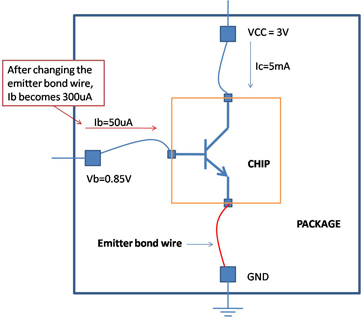cmosbjt
Full Member level 5
Hi, I have trouble using a bipolar transistor without ESD protection. As shown in the picture. When the open face package is built, the transistor works fine.
The collector current: Ic = 5mA,
The base current: Ib = 50 uA,
The base voltage: Vb = 0.85V
As you know by changing the emitter downbond, we can adjust the RF gain. So we change the emitter bond wire once in a while. But that cause most the trouble. After changing the emitter bond wire, the BJT draws a lot of base current in order to maintain the Ic and Vb:
The collector current: Ic = 5mA,
The base current: Ib = 300 uA,
The base voltage: Vb = 0.85V
So I believe the device is damaged.
My questions are:
1. Does anyone has similar experience as this one?
2. Do you know what is the mechanism of the damage? Any reference articals?
3. Is there any failure analysis procedure I can do to confirm/verify the damage?
4. How do you handle this unprotected device if changing the bondwire is neccesary?
Thanks

The collector current: Ic = 5mA,
The base current: Ib = 50 uA,
The base voltage: Vb = 0.85V
As you know by changing the emitter downbond, we can adjust the RF gain. So we change the emitter bond wire once in a while. But that cause most the trouble. After changing the emitter bond wire, the BJT draws a lot of base current in order to maintain the Ic and Vb:
The collector current: Ic = 5mA,
The base current: Ib = 300 uA,
The base voltage: Vb = 0.85V
So I believe the device is damaged.
My questions are:
1. Does anyone has similar experience as this one?
2. Do you know what is the mechanism of the damage? Any reference articals?
3. Is there any failure analysis procedure I can do to confirm/verify the damage?
4. How do you handle this unprotected device if changing the bondwire is neccesary?
Thanks
